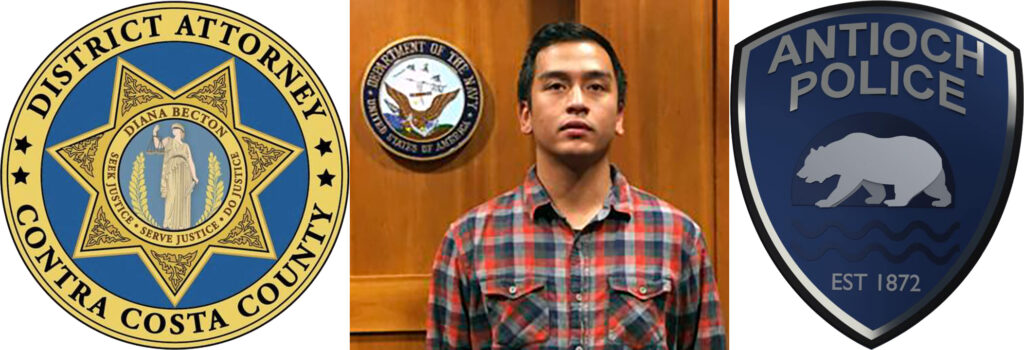Contra Costa DA Report: No evidence of criminal offense by Antioch Police officers in death of Angelo Quinto

“…Antioch Police officers engaged with Quinto in a manner that was lawful and objectively reasonable under the circumstances…an internal examination showed no bone fractures or damage to Quinto’s larynx and trachea…” – Contra Costa District Attorney
Quinto died in the hospital three days later not in police custody
By Allen D. Payton
The Contra Costa District Attorney’s Office announced Friday, Sept. 2, 2022, that it had concluded there is no evidence of criminal offense by Antioch Police officers in the December 2020 death of 30-year-old Angelo Voithugo Quinto. The D.A.’s Office released a 39-page Law Enforcement Involved Fatal Incident (LEIFI) report as part of Contra Costa County’s protocol to investigate incidents when officers or civilians are shot or die during an encounter with law enforcement. The report is available on the District Attorney’s website and here: Angelo Quinto LEIFI Report Final
The incident occurred on December 23rd and Quinto died in the hospital while not in police custody three days later on Dec. 26th.
According to the CCDA, the purpose of the report is to independently determine criminal liability in fatal incidents when law enforcement is involved. During a criminal trial, the District Attorney’s Office – which represents The People of the State of California — has the burden of proving beyond a reasonable doubt that a death was not justified.
Part of the LEIFI report contains a legal analysis of the evidence in the death of Quinto. That analysis determined the Antioch Police officers engaged with Quinto in a manner that was lawful and objectively reasonable under the circumstances. Moreover, the report notes that the officers utilized reasonable force during their contact with Quinto [PC 835a(a)(3)].
The report confirms what both the Contra Costa County Coroner’s Office and then-Antioch Police Chief Tammany Brooks said during a March 2021 press conference and is in spite of the rush to judgment by Antioch Mayor Lamar Thorpe and Councilwomen Monica Wilson and Tamisha Torres-Walker, and the accusations by Quinto’s family members that the police officers caused his death. It also undermines the naming of the legislation, AB 490, entitled the Angelo Quinto Act, banning law enforcement from restraint techniques that cause asphyxia. (See related article here)
Brooks said that officers did not kneel on his neck during the incident. In addition, he said, “according to the results of a preliminary investigation, at one point during the handcuffing, an officer did briefly – for a few seconds – have a knee across a portion of Angelo’s shoulder blade. This is a common control technique taught at CA POST approved Police Academies for prone handcuffing. At no point did any officer use a knee or any other body part to gain leverage or apply pressure to Angelo’s head, neck, or throat, which is outside our policy and training.”
Then, in August 2021, a Contra Costa Coroner’s Inquest Jury found that Quinto’s death was an accident. (See related article)
Background
The circumstances surrounding this incident were initiated with a 911 call from Angelo Quinto’s sister on December 23, 2020, at around 11:10 pm. Quinto’s sister wanted law enforcement’s help after Quinto was being erratic, physically aggressive, and harming his mother. Quinto’s mother could be heard in the background of the call saying “I can’t breathe. Stop it.” while Quinto’s sister told the 911 operator that he was strangling Mrs. Quinto.
Antioch Police officers arrived about a minute later. They were met by Quinto’s sister, who was clutching a hammer to protect herself from her brother. Officers heard a commotion coming from Quinto’s bedroom. When they entered the room, they saw Quinto’s mother struggling with him in a bearhug hold on the ground. Officers separated the two. One officer kneeled and placed one knee on Quinto’s shoulder to handcuff him while the other held onto his legs. This was the extent of force utilized by the two officers to restrain Quinto, and to prevent him from harming himself, family members, or the officers.
Police told Mrs. Quinto that her son was not under arrest. Rather, emergency responders were on their way to transport him to a hospital for any physical injuries. He would also receive a mental health evaluation while being treated at the medical facility. While one officer went to his patrol vehicle to get the needed paperwork, emergency medical crews arrived on the scene. They rolled Angelo over and noticed he was unconscious, his face was purple in color, and there was blood on the floor and his face. The officers did not strike Quinto in any way, and the autopsy revealed bite marks to Quinto’s inner cheek and tongue. Life-saving measures were administered, and Quinto was transported to a hospital in Antioch — where he died on December 26th.
An autopsy was performed on December 28th by the Contra Costa County Coroner’s Office. The cause of death was Excited Delirium Syndrome due to drug intoxication, psychiatric conditions, physical exertion, and cardiac arrest.
A toxicology report by the Coroner’s Office showed that Angelo Quinto had the presence of caffeine, Levetriacetam (a therapeutic for adults and children with epilepsy), and Modafinil – a drug to stimulate wakefulness – in his system. The County of Santa Clara Medical Examiner-Coroner reviewed the autopsy findings and agreed with its conclusions.
The Quinto family commissioned an independent autopsy, and its findings note the cause of death was restraint asphyxiation. The private autopsy lists petechial hemorrhaging as the basis for such conclusion. An independent toxicology report also found the presence of Fentanyl in Quinto’s blood – in addition to Modafinil and Levetiracetam.
However, of critical importance to the investigation, an internal examination showed no bone fractures or damage to Quinto’s larynx and trachea. While there are conflicting medical opinions as to the cause of death, the accounts of what transpired in the bedroom are consistent among all witnesses in that no police officer applied pressure to Quinto’s neck.
After reviewing the evidence, the method of restraining Angelo Quinto by Antioch Police officers on December 23rd was objectively reasonable under the totality of the circumstances. Therefore, when applying the applicable law and the California District Attorney’s Uniform Crime Charging Standards, there is no evidence of a criminal offense committed by the Antioch Police officers involved in restraining Angelo Quinto.
Contra Costa District Attorney’s Office will take no further action in this case.
Contra Costa District Attorney’s Office PIO Ted Asregadoo contributed to this report.
the attachments to this post:

Angelo Quinto LEIFI Report Final



























